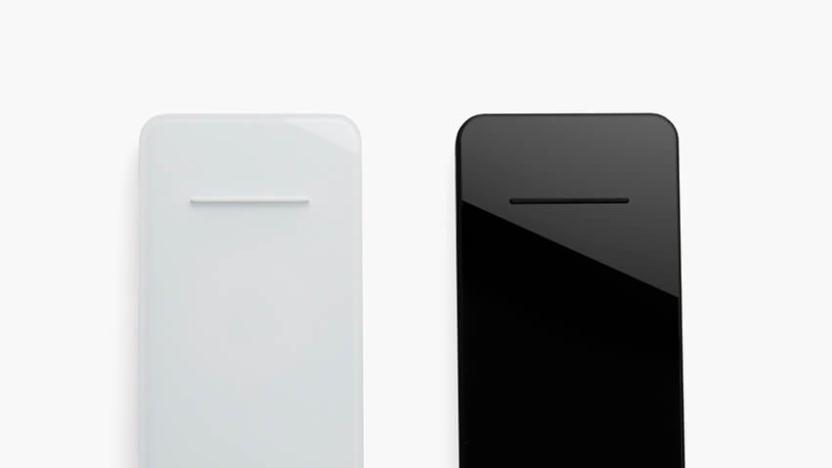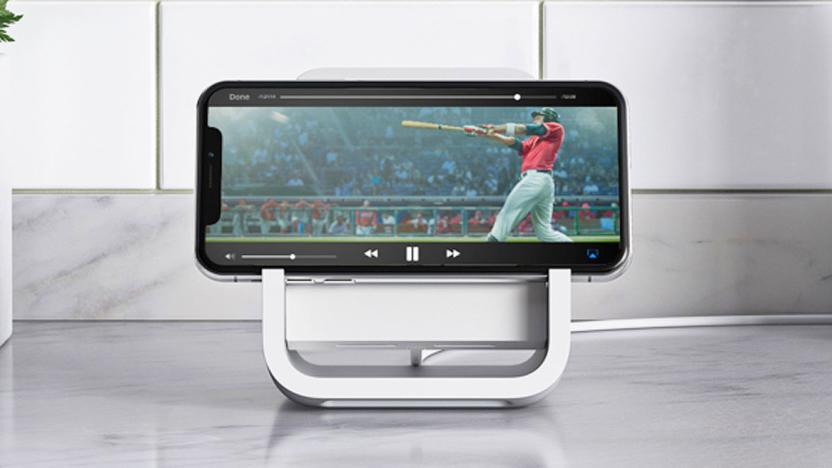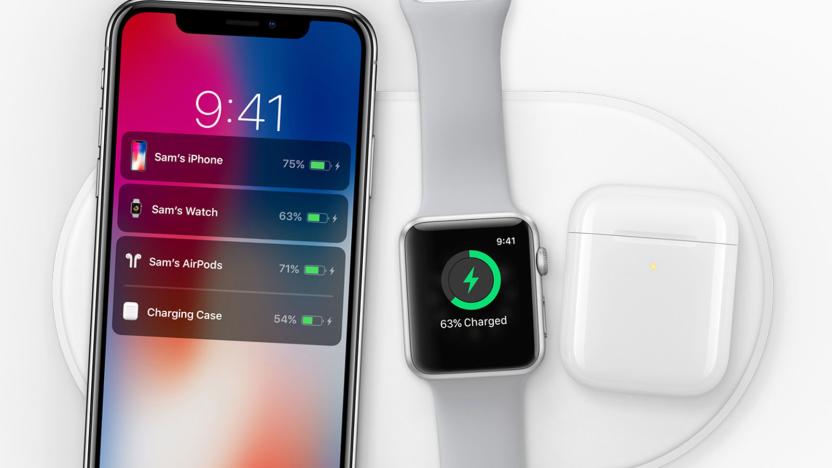WirelessCharger
Latest

The best Qi wireless charging power banks
By Nick Guy This post was done in partnership with Wirecutter. When readers choose to buy Wirecutter's independently chosen editorial picks, Wirecutter and Engadget may earn affiliate commission. Read the full Qi wireless charging power banks guide here. After testing nine competitors over 10 hours, we're confident that Energizer's QE10000CQ 10K Wireless Charging Power Bank is the best all-in-one option for anyone looking for the convenience of a Qi wireless charger at a desk and the portability of a power bank on the go. It also has the fastest ports, and you can charge two devices and the battery itself at the same time. The Energizer QE10000CQ offers better grip on its wireless charging surface than the competition, ensuring that your phone stays in place and keeps charging. It has roughly the same footprint as an iPhone XS but measures about twice as thick, and it's equipped with the best combination of charging options we could find: two USB-A ports (one of which supports Quick Charge 3.0 charging), a Micro-USB input, and a USB-C port for both input and output. (You can fast-charge supported devices through the USB-C port if you have the right cable.) It can fully charge most phones three times before needing to be recharged itself; that's as much battery capacity as we saw from any Qi power bank available during our testing period. myCharge's Unplugged 5K is a good option if you prefer a small, inexpensive charger and are willing to make a few sacrifices. It's more affordable than the Energizer but has half the battery capacity (most phones can get about one and a half to two full charges from this myCharge model). In our tests, the Unplugged 5K wirelessly charged just as quickly as the Energizer, getting a fully drained phone to about 30 percent after an hour. Through the two USB-A output ports, you can expect charging speeds at least twice as fast as with wireless charging, but the unit doesn't offer a USB-C port for even faster charging than that. The white plastic body flexes when you press against it, and this power bank has less grip for keeping your phone in place.

Tesla's wireless charger is back (and it's cheaper)
If you missed out on getting Tesla's wireless phone charger when it was first released, you may want to head over to the company's website ASAP. The automaker has relisted the device for sale, and it even costs $16 less than before. From $65, the Qi-certified charger will now set you back $49 -- still more expensive than alternatives with similar specs, but a lot of Tesla fans probably wouldn't mind paying that much. The wireless device comes in a glossy case and has a 6000mAh battery that can charge at 5W.

Logitech's wireless iPhone charging stand helps you watch movies
Wireless chargers are often finicky things: they tend to require that you place your phone just so, and stands usually preclude you from using your phone in anything but a vertical position. Logitech and Apple think they can lick both of those problems at once. They've teamed up on Powered, an iPhone-oriented wireless charging stand that promises to keep your device topped up no matter how you're using it. The cradle design both simplifies placement (just drop it in and go) and lets you charge while the phone is turned sideways -- helpful if you're determined to finish watching a movie when you return home.

Samsung may have an answer to Apple's AirPower wireless charger
Whenever Apple releases its AirPower multi-device charger, it might have some fresh competition. Recently discovered images and listings have revealed Samsung's Wireless Charger Duo, which (as the name implies) could offer fast charging to two devices at once. It wouldn't be as flexible as Apple's device since you'd need to place your devices on specific spots. However, you could top up a phone and the upcoming Galaxy Watch at the same time, or even two phones at once if you're using it as a family charging station.

Apple's AirPower wireless charger could launch around September
Apple's iPhone X, iPhone 8 and 8 Plus are the company's first devices to include wireless charging support. Back when they announced last September, Apple also said it would be releasing its own wireless charging mat, called AirPower. This wasn't like every other mat out there, though, in that it could charge multiple devices at once -- an iPhone X, Apple Watch Series 3 and a set of AirPods, for example. The AirPower was given a vague 2018 release date, but according to sources speaking to Bloomberg, development of the mat has been marred with issues. Apparently it was expected to be on sale by this month, but is now likely to hit shelves around September, probably with the AirPods wireless charging case in tow.

Samsung's stylish mobile accessories are launching worldwide
What you see above is Samsung's suite of stylish accessories, each meant to be paired with a smartphone or tablet for entertainment and functional purposes. Up until today, the company had only offered these products in South Korea, but starting in November they'll arrive at select markets worldwide. There are six peripherals total, including a wireless charging tray, a battery pack, a Bluetooth LED light, in-ear headphones and two wireless speakers (one of which features 360-degree audio). Naturally, these have one thing in common, and that's their sleek, minimalist design.

Future Cadillacs to come with dual-standard wireless chargers
If you're thinking of buying a new Cadillac soon (congrats!) and you're also big on gadgets, you may want to keep an eye out for some specific models. Visteon, a car electronics supplier that conjured up a smart infotainment system in 2013, is set to debut its wireless charger in the 2015 ATS luxury sedan. It will also be installed on the CTS Sports Sedan this fall, though, as well as the Escalade SUV and other General Motors cars by the end of 2014. Unlike most wireless chargers, Visteon's works with two standards -- Qi and Power Matters Alliance (PMA) -- similar to the ChargeSpot Pocket out of Canada. The dual-standard capability future-proofs your in-car charger... unless manufacturers decide to stick to another standard instead.

Wireless Charger for Nexus 5 and Nexus 7 available today on Google Play
Google's Nexus Wireless Charger, designed to work with the Nexus 4 and 5 smartphones and the Nexus 7 tablet, is available for purchase today on Google Play. The compact Qi power cube ships with a 9-watt AC adapter and a micro-USB cable, and it may make it to your doorstep by the end of the week (if you opt for the $17 overnight delivery). For residents of Hong Kong and India, the good nws is that the Nexus 5 and Nexus are now available on Google Play. The charger will run you $50 plus tax on its own, and another $5.29 for ground shipping. Snag it now at the source link below.

Nexus 4 Wireless Charger hands-on
Palm's Touchstone dock immediately came to mind when we first saw LG's Nexus 4 Wireless Charger last fall (now available for $60 in the Play Store). Both devices are circular, with a micro-USB port in back and a slanted front surface on which to rest the phone. That's where the similarities end -- while the Touchstone is cylindrical and uses a proprietary wireless charging system, the Nexus 4 Wireless Charger is larger, spherical and Qi-compatible. Another major difference is that Palm's dock uses permanent magnets to line up and secure the handset, and LG's accessory relies primarily on the friction / suction between a rubber ring and the glass back of Google's flagship phone. Design-wise the Nexus 4 Wireless Charger looks similar to a smaller Nexus Q cut in half, down to the matching recessed square connector cutout. In the box you'll find a 5V 1.8A AC adapter (vs. 1.2A for the one supplied with the Nexus 4) along with a micro-USB cable (longer than the one provided with the handset). The manual warns to "use only the power adapter and micro-USB cable that come with your Nexus 4 Wireless Charger", but we didn't have any trouble with other USB power sources beyond longer charging times. We tested the dock with the Nexus 4, Droid DNA, Lumia 920 and Lumia 822 (with the optional Wireless Charging Cover) -- basically, LG's accessory provides the same experience as Nokia's Wireless Charging Plate ($50), which is also Qi-compatible. The $10 difference buys you a matching design and a spare USB power adapter and micro-USB cable (Nokia's plate comes with a proprietary AC adapter). It takes about 4 hours to fully charge Google's flagship phone using wireless power -- check out the gallery above for some action shots.

Alliance for Wireless Power approves its specification, edges closer to truly cable-free charging
Design by committee might not be the death knell for technology after all. Over four months after the Alliance for Wireless Power was founded in earnest, the coalition has already greenlit a specification for its partners to work from. The guideline lets device makers start building devices that charge through a magnetic resonance technology more forgiving of distance and material than Qi while simplifying the process through short-range wireless formats like Bluetooth 4.0. While the A4WP group hasn't made all the details public, it's holding meetings this week to speed up the commercialization process -- it's here that we'll learn whether the corporate bureaucracy is just as quick at getting wireless charging hardware into our hands as it is handshaking on standards.

LaunchPort releasing AP.3 sleeve for juicing your new iPad the inductive way
LaunchPort is finally releasing a sleeve for the new iPad, which makes it compatible with the company's inductive charging gear. It goes on sale in September for a hefty $149, and of course, you'll also need at least one $199 tabletop or wall mount to connect it to. The sleeve also works with the iPad 2, and if you're thinking about getting one, be quick -- it's only a matter of time before resonance charging renders inductive juicing a little passé.

Intel, IDT to make resonance charging a reality, see reference chipset coming in first half of 2013
Intel has been talking up wireless charging for years, to the point where we thought its implementation would forever remain a concept for the lab. Not so: Intel is having Integrated Device Technology (IDT) build a real-world chipset to support resonance charging in our gadgets. The lofty goal is to have a ready-made platform for charging up a mobile device or peripheral just by keeping it close to another device with a charger built-in, such as an Ultrabook; there's none of the unseemly contact plates used with inductive wireless power. Intel's commitment is still very much early and won't put a full, two-way resonance chipset into the hands of hardware makers until sometime during the first half of 2013, let alone into a shipping product. We'll take it all the same, as it just might be the first step toward embracing wireless power on a truly large scale.

Verizon-branded Galaxy S III wireless charging kit starts showing up at retail stores
Back when we met the Galaxy S III for the very first time, Samsung promised a wireless charging solution would be coming soon to its sleek and potent slab. Unfortunately, Sammy's power-boosting companion's been hit by hapless delays that have prevented it from seeing the light of day. Now, thanks to a few recent shots from Phone Arena, it looks like at least some S3 owners could see a bundle in the near future, albeit not the official one from the Korean outfit. According to the site's kind tipster, Verizon's allegedly pricing the charging station at $50, while the rear case is expected to be around $40 -- making it about $90 for the entire kit. Naturally, this could change at any given moment, but hey, at least we know it's out there.

WPC updates Qi standard, increases inductive charging distance to 40mm
It seems that Power Matt just got a bit more, er, powerful. The Wireless Power Consortium announced today that it's improved the Qi inductive-charging standard to "include longer range magnetic resonance wireless charging." Effectively, this means charging stations that are up to spec will be able to transmit up to 5 watts of power from distances of 40mm (up from 5mm, previously) to Qi-enabled devices. The WPC says it's ideal for pushing power through the likes tables and counter tops, and that it currently has 12 types of compatible transmitters ready for action. All in all, it certainly seems like a solid step for finally getting rid of all that cable clutter at your workstation -- especially if it'll rid users of those less-than-pretty looking charging bases. Maybe a last-minute add-on to your Uppleva, IKEA?

Chrysler's Mopar division brings wireless charging to 2013 Dodge Dart (video)
The idea isn't new to the aftermarket crowd, but Mopar has just announced the summer arrival of the industry's first OEM wireless power mat, which is designed specifically for the 2013 Dodge Dart. It'll fit snugly within the center console tray, and will charge any properly equipped MP3 player or smartphone. The power mat will retail for $200 and will be available from Chrysler's network of dealers. As for the 2013 Dart itself, it'll set you back a mere $15,995. You'll find an inside peek at Mopar's solution, along with the full PR, right after the break.

The Engadget Interview: Duracell President Stassi Anastassov on future battery tech (video)
It's 2012, and we're connected to the web every second of every day. And then, near the end of each daily cycle, it all stops. "My battery is dead." Is it really your battery that's become depleted? Of course it's not, though it certainly feels as though it might as well be. Stassi Anastassov experiences that daily setback just like you and I and the rest of the world. But the Duracell President and long-time Procter and Gamble executive is in a position to find a way around it, and that's exactly what he plans to do. We sat down with Anastassov in our New York City office to chat about the past, present and future of battery tech, and we even had a chance to meet the Duracell Bunny (yes, that furry hare was property of the "Trusted Everywhere" company long before it made its move to Energizer). So how does P&G plan to transform the portable power industry, and what's that Duracell Powermat joint venture all about? You'll find the answers to those questions and more in our interview just past the break.

Hertz charges into EV Plugless Power pilot program, can't say it three times fast
Hertz has been offering up electric vehicles amongst its fleet of rental cars, and now it's getting ready to pull the plug. The company is teaming with Evatran to test out the those cool little Plugless Power discs, installing some at its corporate headquarters this month. Hertz, along with a number of other companies will be logging "feedback on daily usage routines, user interfaces, and any additional functionality needed." No word on when such technology might see wider distribution.

Oregon Scientific at CES 2012: new weather monitoring and a Qi charging stations, an action cam and more
As usual, the folks at Oregon Scientific are rolling out a bundle of products at CES. When the weather gets bad, the company's new Portable Emergency Alert Radio can come to your rescue to keep you updated as the world ends (it is 2012, after all) for $79. It can tune into AM/FM radio, NOAA weather radio, and Specific Area Message Encoding (SAME) location-based alerts, plus it can be charged via its solar panel or hand crank -- and a USB port's on board to keep all your other devices in the juice, too. There's the ATCMini action video camera that joins the company's other, action cam offerings. The ATCMini weighs a scant 2.3 ounces and records 720p video at 30fps, shoot 1.3 megapixel stills and is waterproof up to 65 feet (20m). It stores all your pics and vids on a MicroSD card, and you can show off your extreme exploits on the big screen via a TV-out jack. The action cam comes with a helmet mount, but there are handlebar, surfboard, and skateboard mounts sold separately as well. PR and a gallery of either awaits you below, and stay tuned for our hands-on impressions later today. Update: Don't forget to peep the Time and Wireless Charging Station+ and the Remote Weather Access Platform.

Rohm Wireless Power Transmission system hands-on (video)
Wireless power demos abound at CEATEC, and Rohm Semiconductor had their own variant on hand with a complete mix of direct-draw gadgets, along with the omnipresent charging iPhone 4 (or was it a 4S?). Like Murata's prototype, the Rohm flavor uses square electrodes instead of the coils that you'll find in traditional wireless power solutions, like Qi. But unlike that seemingly identical solution from Murata, this version supports much greater power efficiency -- something in the 92 to 93 percent range (compared to the competing pad's 70-percent efficiency rating). That means that the prototype that we're looking at here loses just seven to eight percent of power during transmission -- which is still unacceptably high, mind you, but far more tolerable. Rohm's Wireless Power Transmission system also allows you to charge or power devices by placing them anywhere on the pad, rather than directly over charging positions, and it supports much greater transmission, with one prototype outputting up to 100 watts. Since power efficiency isn't something we could verify visually, what we could see at the company's demo did appear to work quite well. Powering a gadget is as simple as dropping it on the pad. Well, resting it gently -- this is a prototype we're talking about, after all. The 50-watt pad was able to power a fan, LED light, and a couple of charging smartphones without issue. The light and fan jumped to full power as soon as they made contact. A second pad got the juices flowing to a large OLED light panel, which was plenty bright when positioned on its own pad, but glowed quite dim when joining other devices. There weren't any charging laptops on hand, like we saw over at Murata, but with power output at 50 and 100 watts, either pad could theoretically support it. Like many of the prototypes we've seen at CEATEC, there aren't any plans to actually bring the system to market, but the technology could be used in other devices. We go hands-on after the break.%Gallery-135773%

Murata Wireless Power Transmission System supports laptops, we go hands-on (video)
Do we really need another wireless charging system that's incompatible with industry standards? Murata seems to think that we do. The company's prototype uses neither conductive nor inductive transmission, instead bringing its new capacitive coupling technology to the cordless charging mix. Capacitive coupling uses square transmitter and receiver electrodes, instead of the coils used with Qi devices. It also doesn't require a physical connection like near-obsolete conductive tech, which dictates that both the charging pad and receiving device use metal connectors that must be joined to transfer current. The Murata system is far from being production-ready, with only 70 percent efficiency (30 percent of electricity is lost during transmission). The sample the company had on hand can support 16 watts of output with a maximum of 2.1 amps, making each pad capable of charging several small gadgets, or one larger device, like a laptop. Murata seemed more interested in demonstrating the concept behind capacitive coupling than actually proving that it works -- the laptop we saw "charging" was a plastic mockup, though the base did glow red when the laptop's charging pad came into contact (though it also glowed blue at times, as you can see in the image above). We did take a close look at an iPhone case, however, which appeared to be remarkably thin -- much thinner than models from Powermat, for example, though the case does extend below the dock connector. Another advantage of the square electrodes is that you don't need to place devices in a certain position on the mat in order for them to charge -- they simply need to be positioned within the general charging area. We take a closer look in the video after the break.%Gallery-135770%









